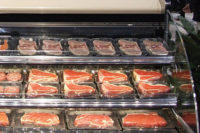The process of brazing ACR tubing is a common task for many refrigeration technicians. Although this is relatively simple, there are some system problems that can occur if some basic brazing procedures are not followed.
First, you should always sweep a non-oxidizing gas such as nitrogen through the tubing during the brazing process. A nitrogen sweep of 1 to 2 cfm through the tubing is an effective means of expelling any oxygen from the inside of the tubing which will prevent the formation of oxidation on the inner walls. If oxidation develops inside the tubing, it can flake off and be carried throughout the system along with the refrigerant and oil. This scale can then cause a restriction to refrigerant flow through some common components such as the liquid filter/drier, metering device, etc.
An improperly brazed joint can also allow refrigerant to escape from the system. The brazing alloy needs to flow into the joint. Even though it melts and forms a fillet, if it does not flow into the joint you may not have a leak free joint. The outside of the joint may be hot. However, if the inside is not up to temperature, the alloy may not flow properly into it. Remember to heat the tube first; apply heat at the point just adjacent to the fitting. Then work the flame around both the tube and the fitting until both reach the brazing temperature. When both have reached the brazing temperature, feed the alloy into the joint, momentarily directing the flame to the tip of the filler metal to begin the melting process. Then sweep the flame over both the tube and the fitting to keep the metals at the brazing temperature while feeding the filler metal into the joint.
Another possible problem is when the brazing alloy balls up instead of running into the joint. This can be the result of several different problems:
1.The tubing or the fitting are not reaching the brazing temperature and the filler metal is being melted by the flame rather than the base metal;
2.The joint has been overheated and the flux is no longer active; or
3.The tube and the fitting have not been properly cleaned.
When working with smaller diameter tubing, another potential problem is the possibility of filling the joint with too much alloy and either partially restricting refrigerant flow or even creating a total blockage. When working with a 1/8-inch flat brazing rod as the filler metal, a good technique is to make a small 90-degree bend at the end of the brazing rod before heating the joint. Make the bend so the short end is the length of alloy needed for the joint. For example a ½-inch fitting may only require 7/8 inch of alloy. Consult with the manufacturer of the brazing alloy you use and see how much is required for the different size joints and then bend the end of the rod to the required length - this will serve as an excellent gauge of how much alloy to use.
Again, brazing is normally an easy task, but don’t forget to follow the basics. If not done properly, it can lead to a failed system, an upset customer, and a very frustrated technician.
Publication date: 05/02/2011
Related Articles
Related Products
See More ProductsSee More ProductsEvents
View AllSubmit An EventView AllSubmit An EventRelated Directories
×
Copyright ©2024. All Rights Reserved BNP Media.
Design, CMS, Hosting & Web Development :: ePublishing










